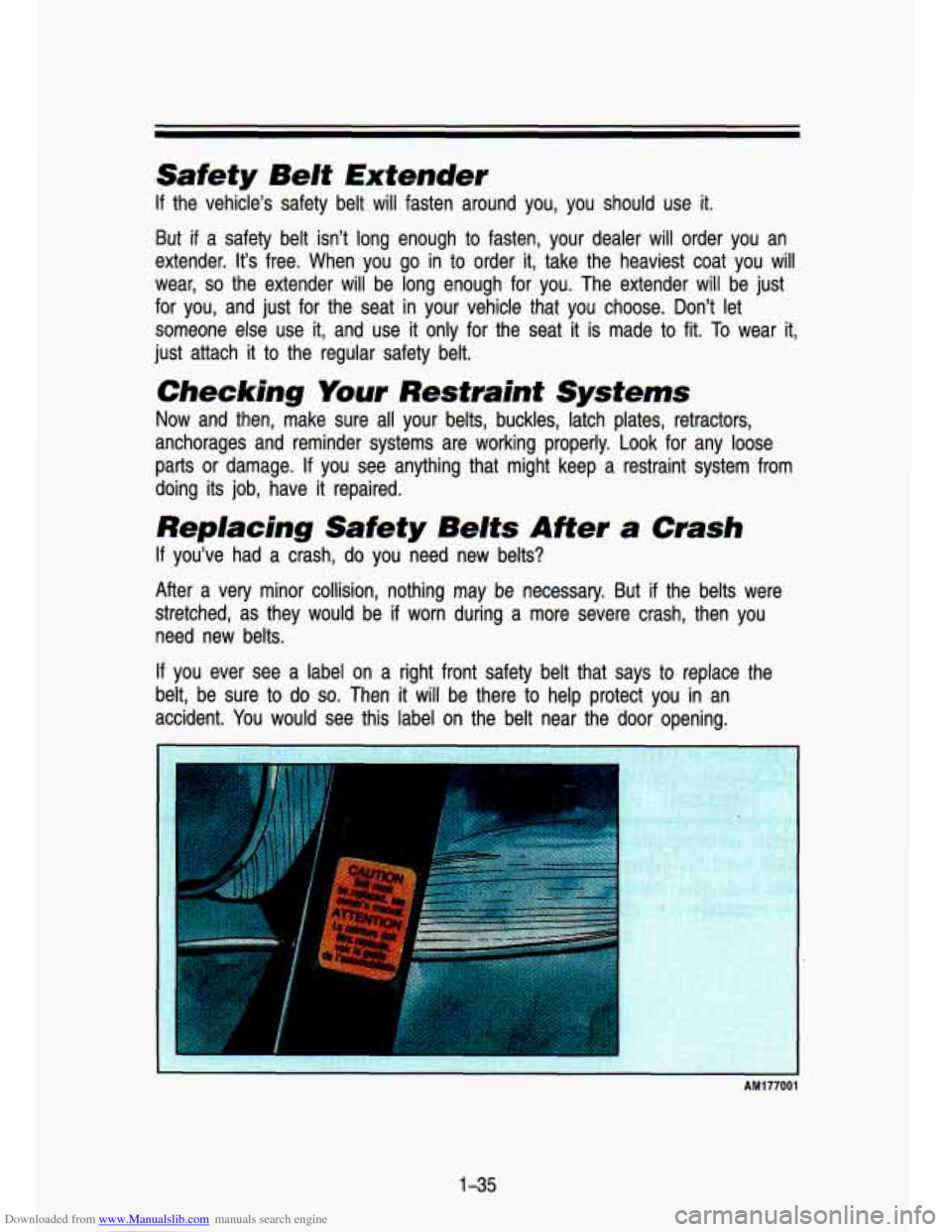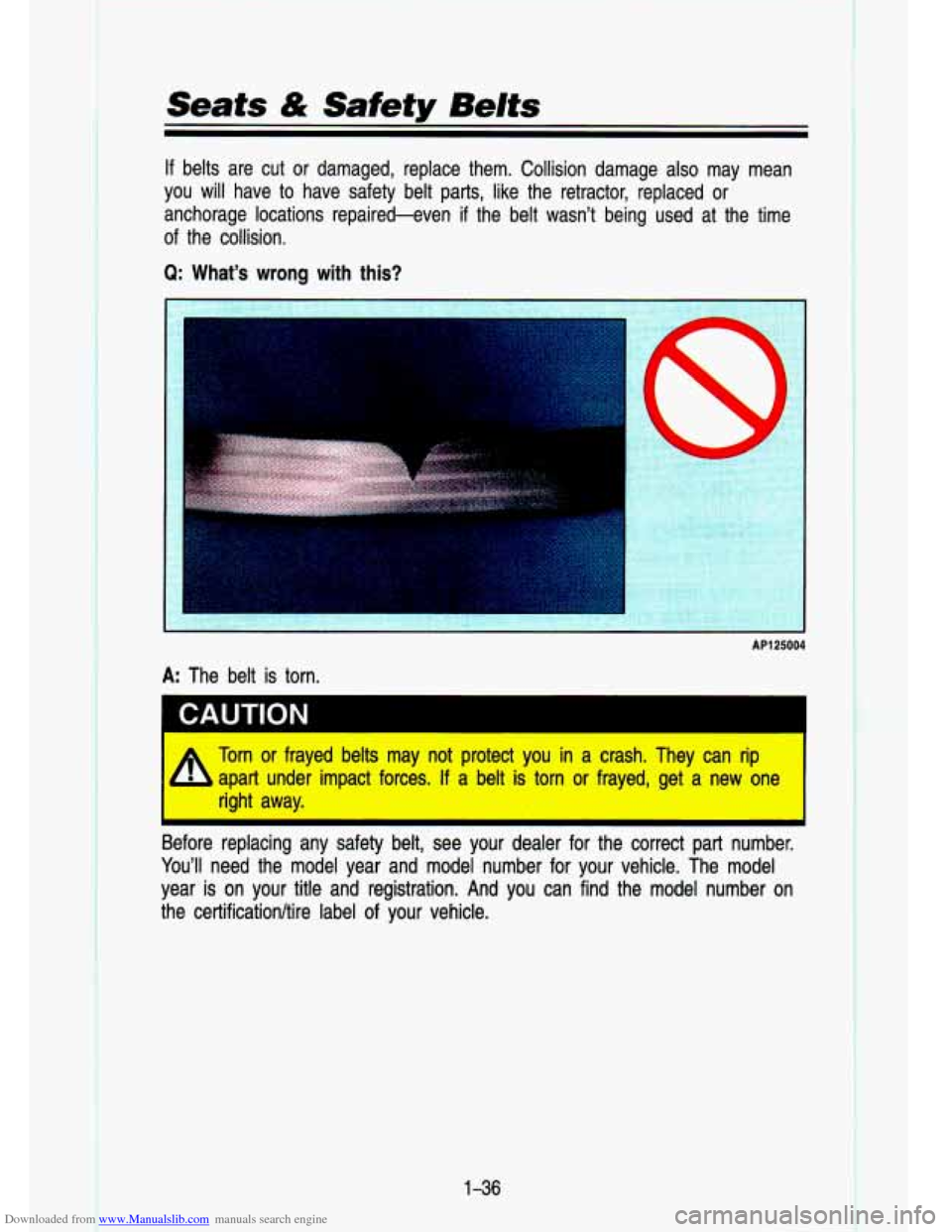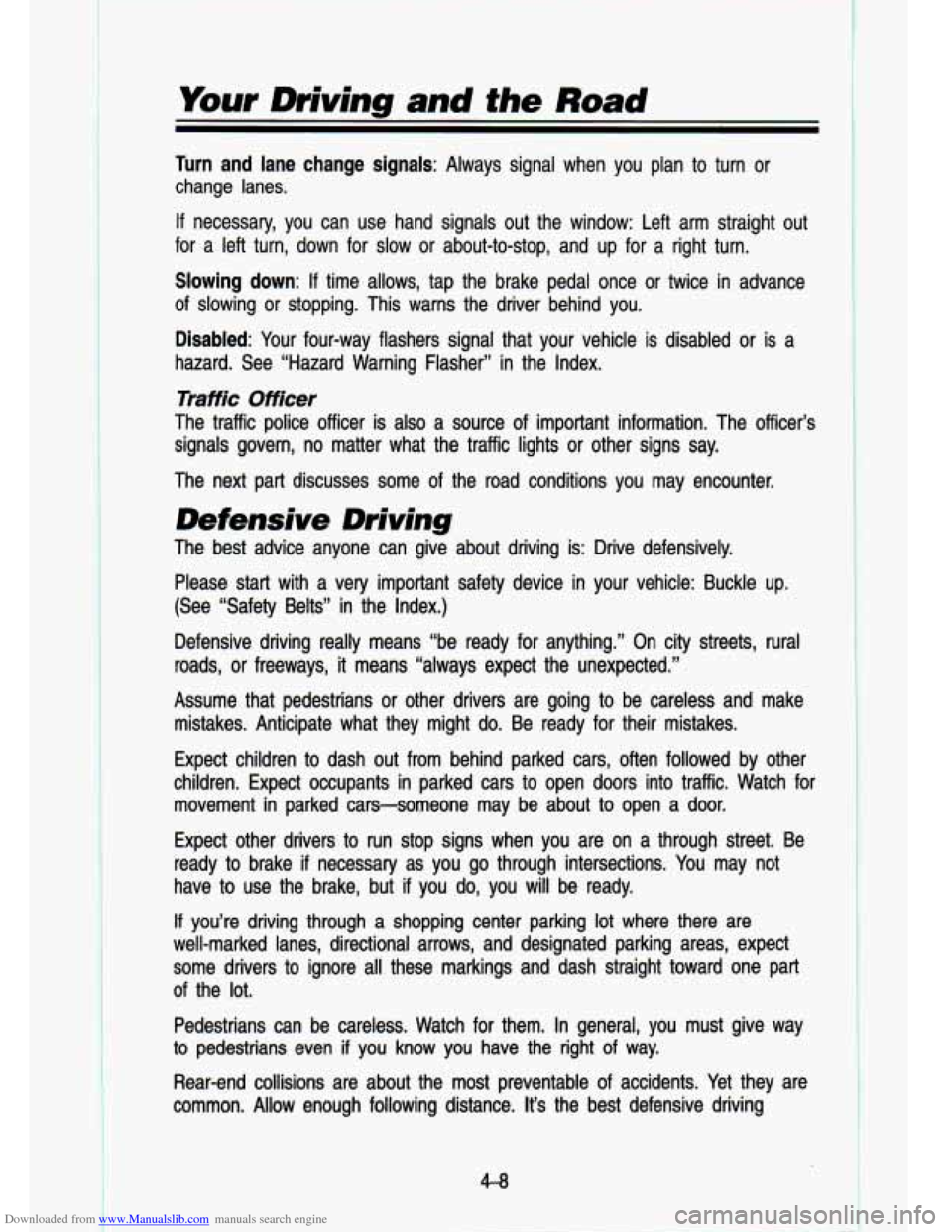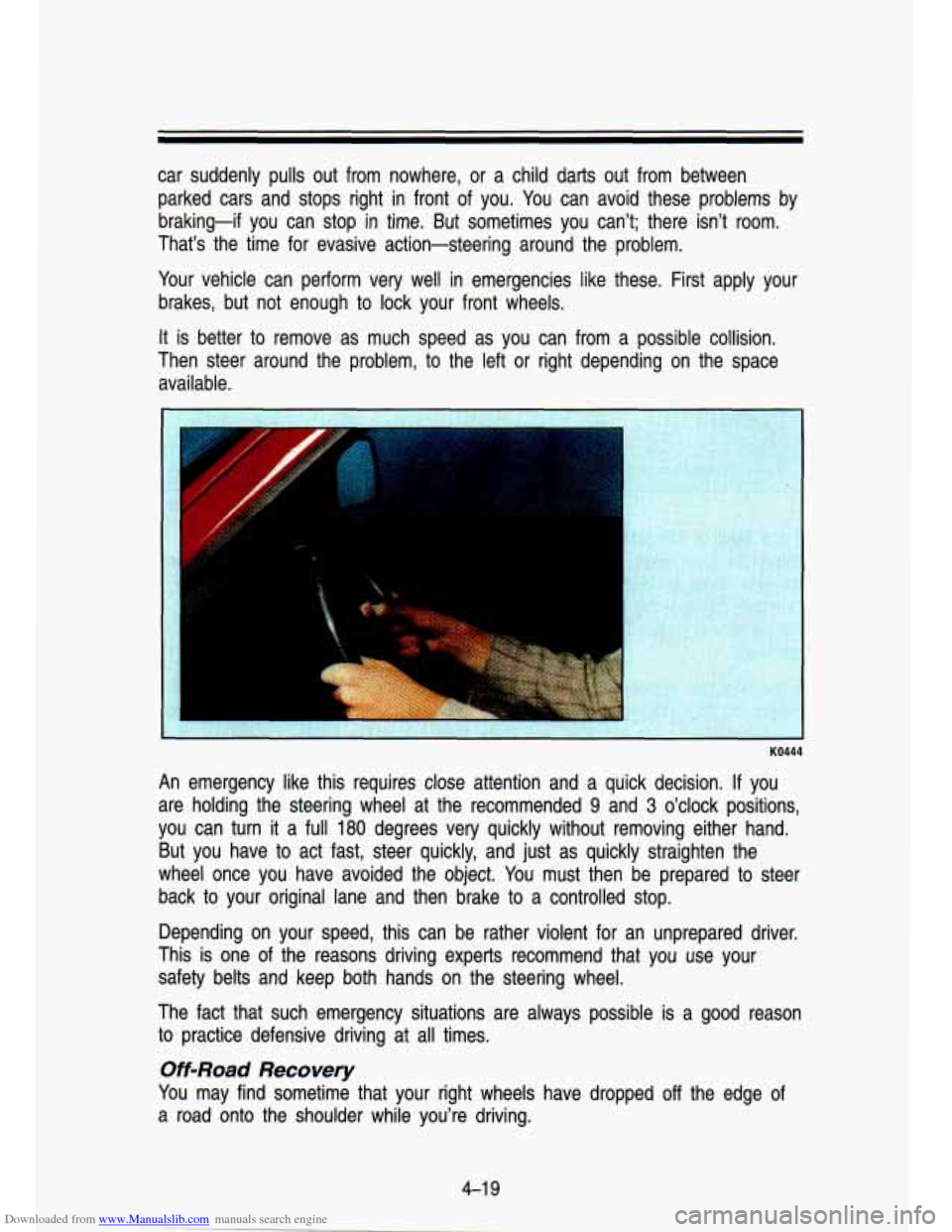1993 CHEVROLET S10 belt
[x] Cancel search: beltPage 49 of 356

Downloaded from www.Manualslib.com manuals search engine Safety Belt Extender
If the vehicle’s safety belt will fasten around you, you should\
use it.
But if a safety belt isn’t long enough to fasten, your dealer will o\
rder you an
extender. It’s free. When you go in to order it, take the heaviest coat you will
wear,
so the extender will be long enough for you. The extender will b\
e just
for you, and just for the seat in your vehicle that you choose. Don’t let
someone else use it, and use it only for the seat it is made to fit. To wear it,
just attach it to the regular safety belt.
Checking Your Restraint Systems
Now and then, make sure all your belts, buckles, latch plates,\
retractors,
anchorages and reminder systems are working properly. Look for \
any loose
parts or damage.
If you see anything that might keep a restraint system from
doing its job, have it repaired.
Replacing Safety Belts After a Crash
If you’ve had a crash, do you need new belts?
After a very minor collision, nothing may be necessary. But if\
the belts were
stretched, as they would be if worn during
a more severe crash, then you
need new belts.
If you ever see a label on a right front safety belt that says \
to replace the
belt, be sure to
do so. Then it will be there to help protect you in an
accident. You would see this label on the belt near the door opening.
1-35
AM177001
Page 50 of 356

Downloaded from www.Manualslib.com manuals search engine I
.- :i
. 1 ..
Seats & Safety Belts
If belts are cut or damaged, replace them. Collision damage also may mean
you will have to have safety belt parts, like the retractor, replaced o\
r
anchorage locations repaired-even
if the belt wasn't being used at the time
of the collision.
Q: What's wrong with this?
AP125004
I CAUTION
Torn or frayed belts may not protect you in a crash. They can rip
apart under impact forces.
If a belt is torn or frayed, get a new one
right away.
Before replacing any safety belt, see your dealer for the corr\
ect part number.
You'll need the model year and model number for your vehicle. \
The model
year is on your title and registration. And you can find the model number on
the certificationltire label of your vehicle.
1-36
I
8: '.
_. . ..
Page 51 of 356

Downloaded from www.Manualslib.com manuals search engine A
F
K2447
The model number on the replacement belt must be listed on th\
e safety belt you want
to replace.
1-37
Page 58 of 356

Downloaded from www.Manualslib.com manuals search engine f .. :. . I. .
. .. .-
. . .. ., -. .
Features & Controls
Door Locks
1 A Unlocked doors can be dangerous.
' Passengers-especially children-can easily open the doors and fall
out. When a door is locked, the inside handle won't open it.
Outsiders can easily enter through an unlocked door when you s\
low
down or stop your vehicle.
This may not be
so obvious: You increase the chance of being
thrown out of the vehicle in a crash
if the doors aren't locked. Wear
safety belts properly, lock your doors, and you will be far b\
etter
off
whenever you drive your vehicle.
There are several ways to lock and unlock your vehicle:
~~____
KO204
From the outside: Use your door key.
From the inside: To lock the door, slide the lever on your inside door to
LOCK.
~. - -. I.
, .. I
2-6
Page 122 of 356

Downloaded from www.Manualslib.com manuals search engine -. .. ,. L .. .
lndicator Lights
lndicator lights go on when you use your turn signals, change from low beam
headlights to high beams, or when you use your hazard flashers. The next
few pages will also tell you about the indicator lights on your vehicle and
help you locate them.
Charging System Light
KO280
t
The charging system light will come on briefly when you turn on the ignition,
but the engine is not running, as a check to show you it is working. Then
it
should go out once the engine is running. If it stays on, or comes on while
you are driving, you may have a problem with the electrical c\
harging system. It could indicate that you have a loose generator drive belt, or anothe\
r
electrical problem. Have it checked right away. Driving while this light is
on
could drain your battery.
If you must drive a short distance with the light on, be certain to turn off all
your accessories, such as the radio and air conditioner.
It is on the lower
right hand side
of your standard instrument cluster.
2-70
Page 162 of 356

Downloaded from www.Manualslib.com manuals search engine c. -. .. .
Your Driving and the Road
Turn and lane change signals: Always signal when you plan to \
turn or
change lanes.
If necessary, you can use hand signals out the window: Left arm \
straight out
for a left turn, down for slow or about-to-stop, and up for a right turn.
Slowing down:
If time allows, tap the brake pedal once or twice in advance
of slowing or stopping. This warns the driver behind you.
Disabled: Your four-way flashers signal that your vehicle is disabled or is a
hazard. See “Hazard Warning Flasher’’ in the Index.
Traffic Officer
The traffic police officer is also a source of important information. The officer’s
signals govern, no matter what the traffic lights or other sig\
ns say.
The next part discusses some of the road conditions you may encounter.
Defensive Driving
The best advice anyone can give about driving is: Drive defens\
ively.
Please
start with a very important safety device in your vehicle: Buckle up.
(See “Safety Belts” in the Index.)
Defensive driving really means “be ready for anything.” On\
city streets, rural
roads, or freeways, it means “always expect the unexpected.”
Assume that pedestrians or other drivers are going to be careless and make
mistakes. Anticipate what they might
do. Be ready for their mistakes.
Expect children to dash out from behind parked cars, often followed by other
children. Expect occupants in parked cars to open doors into traffic. Watch for
movement in parked cars-someone may be about to open a door.
Expect other drivers to run stop signs .when you are on a through street. Be
ready to brake
if necessary as you go through intersections. You may not
have to use the brake, but if you
do, you will be ready.
If you’re driving through a shopping center parking lot where there are
well-marked lanes, directional arrows, and designated parking are\
as, expect
some drivers to ignore all these markings and dash straight toward one part
of the lot.
Pedestrians can be careless. Watch for them. In general, you m\
ust give way
to pedestrians even
if you know you have the right of way.
Rear-end collisions are about the most preventable of accidents. Yet they are
common. Allow enough following distance. It’s the best defens\
ive driving
4-8
Page 173 of 356

Downloaded from www.Manualslib.com manuals search engine car suddenly pulls out from nowhere, or a child darts out from between
parked cars and stops right in front of you. You can avoid these problems by
braking-if you can stop in time. But sometimes you can’t; there isn’t room.
That’s the time for evasive action-steering around the proble\
m.
Your vehicle can perform very well in emergencies like these. First apply your
brakes, but not enough to lock your front wheels.
It is better to remove as much speed as you can from a possible collision.
Then steer around the problem, to the left or right depending on the space
available.
KO444
An emergency like this requires close attention and a quick de\
cision. If you
are holding the steering wheel at the recommended
9 and 3 o’clock positions,
you can turn
it a full 180 degrees very quickly without removing either hand.
But you have to act fast, steer quickly, and just as quickly straighten the
wheel once you have avoided the object. You must then be prepared to steer
back to your original lane and then brake
to a controlled stop.
Depending on your speed, this can be rather violent for an un\
prepared driver.
This is one
of the reasons driving experts recommend that you use your
safety belts and keep both hands on the steering wheel.
The fact that such emergency situations are always possible
is a good reason
to practice defensive driving at
all times.
Off-Road Recovery
You may find sometime that your right wheels have dropped off the edge of
a road onto the shoulder while you’re driving.
Page 179 of 356

Downloaded from www.Manualslib.com manuals search engine Controlling your vehicle is the key to successful off-road driving. One of the
best ways to control your vehicle is to control your speed. Here are some
things to keep in mind. At higher speeds:
you approach things faster and you have less time to scan the terrain
for obstacles.
you have less time to react.
you have more vehicle bounce when you drive over obstacles.
you’ll need more distance for braking, especially since you’\
re on an
unpaved surface.
I CAUTION
A When you’re driving off road, bouncing and quick changes in direc-
1 tion can easily throw you out of position. This could cause you to
lose control and crash. So, whether you’re driving on or off the road,
you and your passengers should wear safety belts.
Scanning the Terrain
Off-road driving can take you over many different kinds of terrain. You need
to be familiar with the terrain and its many different features. \
Here are some
things
to consider.
Surface Conditions
Off-roading can take you over hard-packed dirt, gravel, rocks, grass, sand,
mud, snow or ice. Each of these surfaces affects the steering, acceleration,
and braking of your truck in different ways. Depending upon the kind of
surface you are on, you may experience slipping, sliding, wheel spinning,
delayed acceleration, poor traction, and longer braking distances\
.
Surface Obstacles
Unseen or hidden obstacles can be hazardous. A rock, log, hole, rut, or
bump can startle you
if you’re not prepared for them. Often these obstacles
are hidden by grass, bushes, snow or even the rise and fall of the terrain
itself. Here are some things to consider:
Is the path ahead clear?
Will the surface texture change abruptly up ahead?
Does the travel take you uphill or downhill? (There’s more discussion of
Will you have to stop suddenly or change direction quickly?
these subjects
later.)
4-25